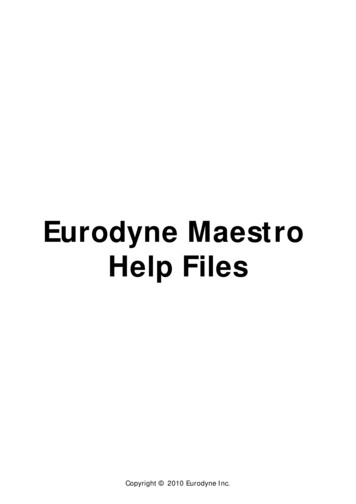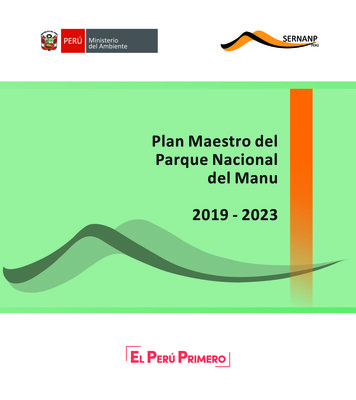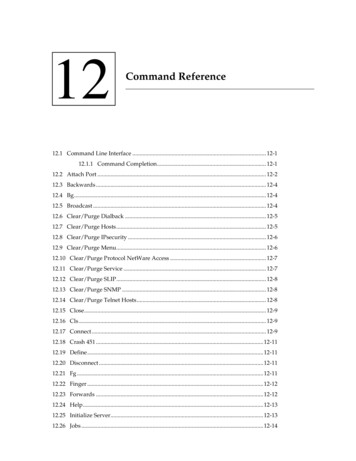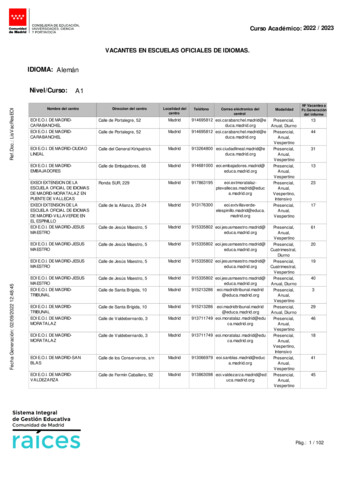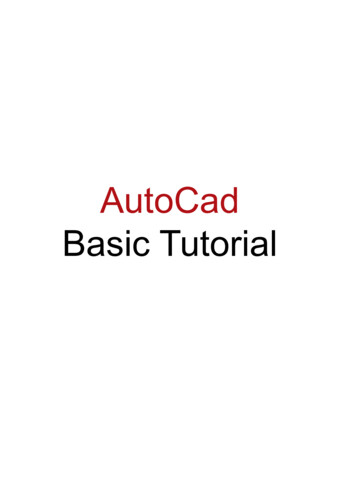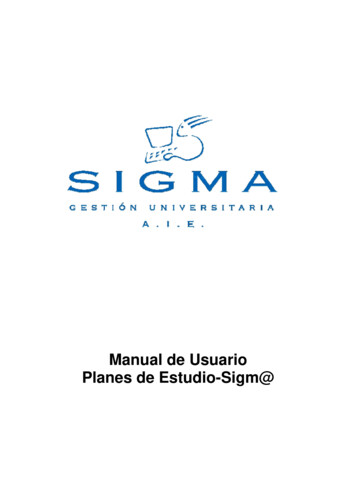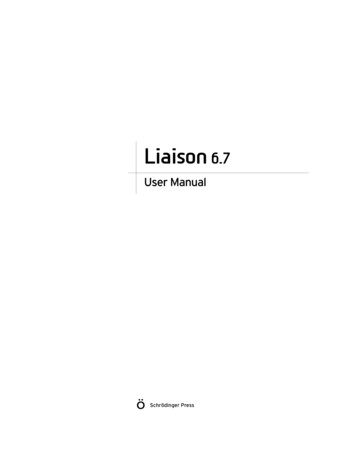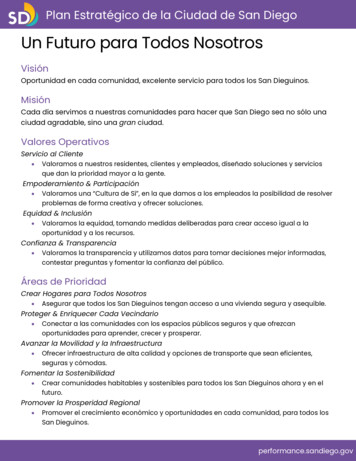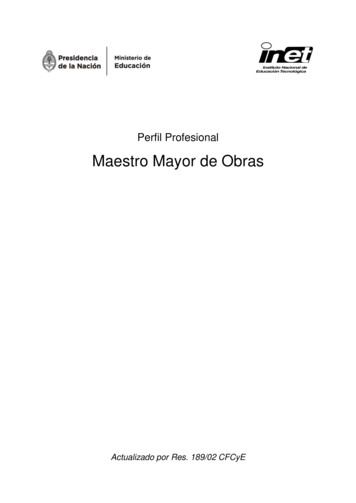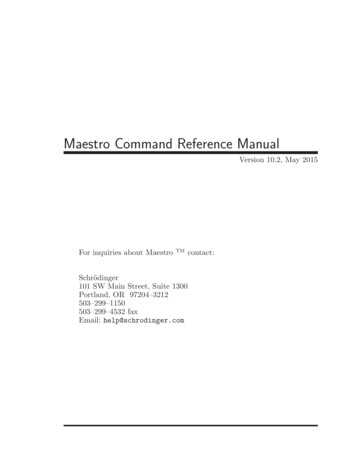
Transcription
Maestro Command Reference ManualVersion 10.2, May 2015For inquiries about MaestroTMSchrödinger101 SW Main Street, Suite 1300Portland, OR 97204–3212503–299–1150503–299–4532 faxEmail: help@schrodinger.comcontact:
Copyright c 2015 Schrödinger, LLC. All rights reserved.Maestro, CombiGlide, Epik, Glide, Impact, Jaguar, Liaison, LigPrep, Phase, Prime, PrimeX, QikProp, QikFit, QikSim, QSite,and Strike are trademarks of Schrödinger, LLC. MacroModel andSchrödinger are registered trademarks of Schrödinger, LLC.To the maximum extent permitted by applicable law, this documentis provided “as is” without warranty of any kind. This documentmay contain trademarks of other companies.Please note that any third party programs (“Third Party Programs”) or third party Web sites (“Linked Sites”) referred to inthis document may be subject to third party license agreementsand fees. Schrödinger, LLC and its affiliates have no responsibilityor liability, directly or indirectly, for the Third Party Programs orfor the Linked Sites or for any damage or loss alleged to be causedby or in connection with use of or reliance thereon. Any warrantiesthat we make regarding our own products and services do not applyto the Third Party Programs or Linked Sites, or to the interactionbetween, or interoperability of, our products and services and theThird Party Programs. Referrals and links to Third Party Programs and Linked Sites do not constitute an endorsement of suchThird Party Programs or Linked Sites.Maestro Version 102009May 2015
Chapter 1: The Maestro Command Language1 The Maestro Command LanguageThis manual contains a listing of all supported Maestro commands, theirfunctions, and their usage options. Use Maestro commands by enteringthem in the Command Input Area of the Main Application Window.The Maestro command language syntax is:keyword [options] [operand]For example:entryimport wsreplace true all true format maestro ligands.maeIn the example given, “entryimport” is the keyword. As this example illustrates, the first item entered must be a keyword, and this keyword mustmatch a known keyword completely, i.e., to all characters. However, Maestrodoes have an alias facility, which allows users to map keywords to shorternames, for example, “entryimport” to simply “import”. See the “alias”command for details.Command options are used to set values that generally correspond to stateswithin the program. As the name “options” suggests, inclusion of these itemsin a Maestro command is not mandatory. However, any number of optionname h value i pairs can be specified. Options can be of type: Boolean(yes/no, y/n, t/f, and true/false are valid values), string, integer, or real.Once an option is set, its value will persist for all subsequent commands untilit is specified again. A command consisting only of a keyword and optionswill set the states corresponding to those option values, but will not performany other action. For example, the command:entryimport format maestro all truewill not import structures from any file. It will only set the format forsubsequent file reading and specify that all structures contained in the subsequently specified file be imported. If the following command is then issued:entryimport ligands.maeall structures from the ligands.mae Maestro file will be imported.The operand is the remaining element of a Maestro command. The type ofoperand required is dependent on the specific command. For “entryimport”,the operand must be a file name. For other commands, it may be one ormore atom numbers, or a string describing arbitrary atom sets, specifiedusing Maestro’s Atom Specification Language (ASL). For more informationabout ASL, see Chapter 3 [ASL], page 5.Maestro 10.2 Command Reference Manual1
Chapter 1: The Maestro Command Language2Maestro 10.2 Command Reference Manual
Chapter 2: Conventions Used in this Manual2 Conventions Used in this ManualThis manual uses a number of typographical conventions to describe thecommand language.The names of keywords are printed in boldface:entryimportThe names of options are printed in italic, and literal choices for that optionare in normal roman:wsreplace trueValues which the user is to replace with appropriate values are representedin angle brackets:entryimport h file name iWhere there is a choice of a number of values, these are shown separated byvertical bars:entryimport format maestro mmod sd pdb mol2If a value is optional then it is enclosed in square brackets:print [ h file name i ]The following conventions are used to describe acceptable values for options:hnimeans an integerhximeans a real numberyes nomeans a boolean value (could also be true false, y n, on off)h text irepresents a string value. If this contains spaces, it must beenclosed in double quotation marksThe following are some conventions used for operands:h atom number irepresents an atom numberh atom1 irepresents the first atom number in the operations, h atom2 i thesecond, and so onh ASL irepresents a valid string in the Atom Specification Languageh ESL irepresents a valid string in the Entry Specification LanguageMaestro 10.2 Command Reference Manual3
Chapter 2: Conventions Used in this Manual4Maestro 10.2 Command Reference Manual
Chapter 3: The Atom Specification Language3 The Atom Specification LanguageThis chapter documents the syntax of Maestro’s Atom Specification Language (ASL).3.1 Why an Atom Specification Language? To provide a flexible way to define sets of atoms in complex macromolecular systems To serve as the basis of a “Sets” facility in Maestro To allow atom specification from textual input which some users findfaster then picking atoms from the main structure window.3.2 The ASL Hierarchyentry molecule chain residue atomThere are five classes which make up the atom specification language. Eachis listed below.In this section the minimum acceptable abbreviation is shown outside thesquare brackets. So for example m[olecule] means that the minimal acceptable abbreviation for molecule is m.e[ntry]This is the top level class in the language. An entry is all atomsin the workspace associated with a single entry in the currentlyopen project.m[olecule]The term molecule is used in the normal chemical sense meaningall atoms which are connected by a single covalent path.c[hain]This corresponds to a chain as specified in the PDB file format.Note that this chain may be a subset of a molecule, e.g., whenchains a linked by disulphide linkages.r[esidue]An arbitrary collection of one or more covalently bound atomswithin a molecule, such as the monomer units in a polymer.a[tom]A single atom.Each class is optional. If absent all entities of that type are matched.Maestro 10.2 Command Reference Manual5
Chapter 3: The Atom Specification Language3.3 Atom SpecificationA complete specification is a class name and some property specified by aproperty name and property list. The syntax is:class.property h propertylist iItems in a property list may be separated by comma, whitespace or both.Ranges (lower-upper) may be used where appropriate. Unterminated rangesare taken to include all available numbers. For example, if there are fourmolecules in the system then the specifications: mol. 2, 3, 4 mol. 2 mol. 2-4 mol. 1are equivalent.In a similar manner, mol. 1, 2, 3 mol. 3 mol. 1-3 mol. 4are equivalent.All names of properties and characters in property lists are treated in a caseinsensitive manner.Wildcards are supported for atom and set names. A ‘*’ will match zero ormore characters and a ‘?’ will match any single character. You can includecomments in a specification by placing a ‘#’ character before the text youwish to hide.In this section the minimum acceptable abbreviation is shown outside thesquare brackets. So, for example, a[tom].pt[ype] means that the minimalacceptable abbreviation for atom.ptype is a.pt.e[ntry].[name]6Because entry names are the only entry propertiesspecifiable using ASL expressions, the word namecan be completely omitted, i.e., entry.name enameand entry. ename are equivalent. Note, however,that the ‘.’ is still required even if the property nameis not included. A valid property list for the ’entryname’ property is a list of entry names. Wildcardcharacters are permitted. For example:entry. e1entry.name recep, lig*Maestro 10.2 Command Reference Manual
Chapter 3: The Atom Specification Languagem[olecule].[number]m[odulo]Because numbers are the only molecular propertiesspecifiable using ASL expressions, the word numbercan be completely omitted, i.e., mol.number 1 andmol. 1 are equivalent. Note, however, that the ‘.’is still required even if the property name is notincluded. A valid property list for the ’moleculenumber’ property is a set of numbers or a range.For example:mol. 1-4mol. 1,2,3,4a property which can be used to select every nthmolecule. For example: mol.mod 10 1 will selectmolecule 1, 11, 21, etc.e[ntrynum]a property which can be used to select moleculesbased on their entry-relative numbering. For example: mol.entrynum 1 will select the first molecule ineach entry.c[hain]a[toms]a property which can be used to select moleculesbased on the number of atoms they contain. Forexample: mol.atoms 200 will select molecules thatcontain exactly 300 atoms. Other examples are:mol.atoms 200-300mol.a 200w[eight]a property which can be used to select moleculesbased on their molecular weight. For example:mol.weight 200.12 will select the atoms that havea molecular weight of exactly 200.12. Other examples are:mol.weight 300.0mol.weight 200.0This class designation allows you to specify atoms using chainattributes. Combine with the ’name’ property.[name]Because names are the only chain properties thatare specifiable by ASL, the word name can be omitted. For example, the specifications chain.name Aand chain. A are equivalent. Note, however, thatthe ‘.’ is required even if the property name is notincluded. A valid property list for the ’chain name’property is a single character representing a PDBMaestro 10.2 Command Reference Manual7
Chapter 3: The Atom Specification Languagechain name. Some examples of equivalent acceptable ’chain name’ expressions are:chain.name Achain. Ac. Ar[esidue]This ASL class designation allows you to specify atoms based onresidue properties. Combine with one of the following propertyspecifications.[name] or [number]Either residue names or numbers (but not both) canbe used in property lists which do not specify a property name For example, the following are valid ASLexpressions:res. ala val leures. 1 2 3and will return atoms which are either in alanine,valine, or leucine residues, or atoms in residues 1, 2or 3, respectively. Residue numbers can be specifiedwith a range, e.g., residue. 1-4 and may includenegative values or zero.pt[ype]The three-letter PDB code for the residue. This isthe default for non-numeric characters in the property list, so the expression res. arg and res.ptypearg are equivalent. A valid property list for ’ptype’is comprised of three-character tokens. For example:res.ptype gly,val,alares. gly val alam[type]The one letter residue codes as used in Maestro. Avalid property list for ’mtype’ is comprised of onecharacter tokens. For example:res.mtype g,v,ares.m g,v,apo[larity]The polarity of the residue. The property list mustconsist only of the following descriptor types:h[ydrophobic]returns atoms in hydrophobic residuespol[ar]8returns atoms in polar residuesMaestro 10.2 Command Reference Manual
Chapter 3: The Atom Specification Languagepos[itive]returns atoms in residues with positiveformal chargesn[egative]returns atoms in residues with negativeformal chargesFor example,residue.polarity hydrophobicresidue.pol pos,negres.pol h pos negsec[ondary structure]The secondary structure of the residue. The property list must consist only of the following descriptortypes:h[helix]returns atoms in helical regionss[trand]returns atoms in strand regionsl[oop]returns atoms in loop regionsFor example,residue.sec helixresidue.sec hel, strres.sec l, spos[ition]The fractional position of the residue. The propertylist must include two real numbers representing afractional range of residue numbers. For example,if there are 100 residues numbered from 1-100, thespecification:residue.pos 0.0 0.1will return residues 1 to 10.i[nscode]The insertion code of the residue. A property listshould include one-character tokens representing insertion codes. For example:residue.inscode awill get all residues with insertion code ’a’, while:res. 25 and res.inscode bwill get residue 25b.Maestro 10.2 Command Reference Manual9
Chapter 3: The Atom Specification Languagea[tom]Atom ptypes and numbers may be mixed in property lists whereno explicit property is specified. For example, the following isvalid:atom. 1,2,3,CAand returns atoms 1,2 and 3 and any alpha carbons.pt[ype]The PDB atom names. A valid property list for’ptype’ consists of acceptable PDB names. This isthe default property for non-numeric components ofproperty lists and, as such, the word ’ptype’ maybe omitted. Note that the ‘.’ is required. The following specifications are equivalent and return the“backbone” atoms in a structure:atom.ptype N,CA,C,Oatom. N,CA,C,Oa. n,ca,c,oNote: see below for a discussion of how PDB atomnames are specified and matched.Wildcards as described above can be applied toptypes.na[me]The atom names. The property list must containvalid atom names. A valid atom name could be astring of any length which:1. must have at least one non-digit character2. must not contain any control characters (ASCIIvalue 0x20)3. must not contain spaces or equal signs, unlessthe name is quotedWildcards as described above can be applied toatom names. Examples:atom.name the 36th carbonatom.na C15, O:66, H-77atom.na C* (returns atoms with namestarting with C)atom.nam ?0* (returns atoms whosename’s 3rd character is ‘0’)n[umber]10The atom numbering. The property list must bea list or a range of numbers. This is the defaultproperty for numeric components of property lists.The following expressions are equivalent and returnthe atoms numbered 1, 2, 3, and 4.Maestro 10.2 Command Reference Manual
Chapter 3: The Atom Specification Languageatom.num 1,2,3,4a. 1 2 3 4atom. 1-4mo[lnum]The atom numbering in the “by molecule” scheme.The property list must be a list or a range of numbers. For example, the expression:atom.molnum 1returns the first atom in each molecule, while thespecification:atom.molnum 1-10returns the first 10 atoms in each molecule.en[trynum]The atom numbering in the “by entry” scheme. Theproperty list must be a list or a range of numbers.For example, the expression:atom.entrynum 1returns the first atom in each entry, while the specification:atom.entrynum 1-10returns the first 10 atoms in each entry.m[type]The Maestro atom type. A valid property list for the’mtype’ property consists of Maestro atom types.The following expression is valid and specifies sp2carbons and oxygens.atom.mtype C2,O2e[lement]The element symbol for the atom. A valid propertylist for the element is a list of standard periodic tablesymbols. To define all carbons and oxygens:atom.ele C,Oatt[achments]The number of bonds the atom has to it. The property list must be a number in the range 0-6, butgreater than ‘ ’, less than ‘ ’, and equals ‘ ’ signsmay also be used. The expression:atom.att 1returns all terminal atoms. The specification:atom.att 2Maestro 10.2 Command Reference Manual11
Chapter 3: The Atom Specification Languagereturns all terminal atoms and other atoms with 2or fewer bonds. The specification:atom.att 0returns all isolated atoms.ato[micnumber]The atomic number. The property list must containnumbers only. Ranges of integers and greater than‘ ’, less than ‘ ’, and equals ‘ ’ signs may also beused. The expression:atom.atomicnum 1returns all hydrogen atoms. The specification:atom.ato 1-6returns all atoms in the range H to C.c[harge]The partial charge on the atom. A valid propertylist contains a value or range of floating point values.The expression:atom.charge 0.400returns atoms with partial charges of 0.400. Theexpression:atom.charge -0.6--0.4returns atoms with partial charges -0.6 to -0.4,atom.charge 0.0returns atoms with negative partial charges, andatom.charge 0.5returns atoms with charges of 0.5 or greater.f[ormalcharge]The formal charge on the atom. A valid propertylist contains a value or range of integer values. Theexpression:atom.formal 0returns atoms with formal charges of 0. The expression:atom.formal -2 -- 1returns atoms with formal charges -2 to -1,atom.formal 0returns atoms with negative formal charges, andatom.formal 1returns atoms with formal charges of 1 or greater.12Maestro 10.2 Command Reference Manual
Chapter 3: The Atom Specification Languaged[isplayed]Whether or not the atom is currently displayed inMaestro. No property list is used. For example, theexpressions:atom.displayed returns the set of alldisplayed atomsnot atom.disp returns all atoms notcurrently displayedsidechain and fillres atom.dispreturns the side chains of residues whereat least one atom is displayed.s[elected]Whether or not the atom is currently selected inMaestro. No property list is used. For example, theexpression:atom.selected returns the set of all atomsselected in the WorkspaceUsing generalized atom properties. Some structures may have additionalproperties available. These are referenced directly by their data names appended onto the "atom." class. These properties are either of integer, real,boolean or string type and the datanames are encoded as beginning withi , r , b or s respectively. It is possible to use these atom properties inconjunction with any other ASL expression. Any atoms which don’t havethese properties associated with them will never match. Some examples ofusing the ASL to address these properties are:atom.i my integer prop1-4atom.b my boolean propatom.r my real prop 4.0 atom.s my string prop LIG3.4 OperatorsA number of operators are supported:3.4.1 The Boolean and OperatorBoolean AND (set intersection). The syntax for this operation is:spec1 and spec2where spec1 and spec2 are valid atom specifications. This operation willreturn the set of atms which meets the specifications spec1 and spec2. Forexample, the expression:mol. 1 and atom. CAMaestro 10.2 Command Reference Manual13
Chapter 3: The Atom Specification Languagewill return the set of all the alpha carbons of molecule 1. The specification:res.num 1-100 and res. alareturns all alanines in residues with numbers in the range 1-100.3.4.2 The Boolean or OperatorThe Boolean OR operator. The syntax for this operations is:spec1 or spec2where spec1 and spec2 are valid atom specifications. This returns the setof atoms which meet either specification spec1 or spec2. For example, theexpression:mol. 1 or atom.ptype CAreturns the set of all atoms that are in molecule number 1, or are alphacarbons. The specification:res.num 1-100 or res.ptype alareturns all residues either with numbers in the range 1-100, or any alanines.3.4.3 The Boolean not OperatorThe Boolean NOT operator. The syntax for this operation is:not spec1where spec1 is a valid atom specification. This returns the set of atoms thatare not part of those defined by spec1. For example, the expression:not atom. CA,C,N,Owill return a set containing all side chain atoms.3.4.4 The fillres and fillmol OperatorsTwo special operations, fillres and fillmol, can be used to “fill out”the atoms defined by a atom specification to complete residue or moleculeboundaries. For example:fillres atom.num 1,100,40will return all the atoms in residues of which atoms 1,100 and 40 are members. In a similar way:fillmol atom.num 1,100,40will return all the atoms in molecules of which atoms 1,100 and 40 aremembers.14Maestro 10.2 Command Reference Manual
Chapter 3: The Atom Specification Language3.4.5 The within and beyond OperatorsThe operators within and beyond can be used to define sets of atoms basedon their distance from a set of atoms defined defined by an atom specification.The syntax for these operators is:within distance spec1which returns the atoms within, i.e, less than or equal to the distance inAngstroms of the set defined by spec1, andbeyond distance spec2which returns the atoms which are further than the distance in Angstromsfrom the set defined by spec2.For example, the expression:within 5.0 mol. 1returns the set of all atoms that are within 5 Å of molecule 1. The expression:beyond 5.0 mol. 2returns all atoms that are farther than 5 Å from molecule 2.The combination of fillres and within or beyond is especially powerful.fillres within 5.0 mol. 1will produce a set containing the atoms of all complete residues that haveatoms within 5 Å of molecule 1. Note that the within operator will alsoreturn the reference set of atoms:within 5.0 mol. 1returns the reference set of all atoms that are within 5 Å of molecule 1 andthose that are part of molecule 1.The and operator, when used with within and beyond, can be used to allowmore specificity:mol. 2 and within 5.0 mol. 1returns the set of all atoms of molecule 2 that are within 5 Å of molecule 1.3.4.6 The withinbonds OperatorA special type of within, one that finds all atoms within a certain numberof bonds of the reference set:withinbonds h num bonds i h spec iFor example:withinbonds 4 atom. 1will find all the atoms that are within four bonds of atom 1.Maestro 10.2 Command Reference Manual15
Chapter 3: The Atom Specification Language3.4.7 The beyondbonds OperatorA special type of within, one that finds all atoms beyond a certain numberof bonds of the reference set:beyondbonds h num bonds i h spec iFor example:beyondbonds 4 atom. 1will find all the atoms that are in the same molecule as atom 1 but beyondfour bonds of atom 1.3.5 Operator PriorityThe order of priority of operators is (in decreasing order): not/fillres/fillmol and/or within/beyondAt equal levels of priority the expression will be evaluated left to right.Examples:within 5.0 mol. 1 or mol. 2returns the set of all atoms that are within 5.0 Å of either molecule 1 ormolecule 2 (or has higher priority).not atom.ptype CA,C,O,N and mol. 1returns the side chain atoms of molecule 1.atom.ptype CA or mol. 1 and not res.pol polarreturns all alpha carbons and atoms in hydrophobic residues of molecule 1.Parentheses can be used to override the order of evaluation:not (atom.ptype CA,C,O,N or mol. 1)produces all atoms either not in the backbone or not in molecule 1.3.6 Implicit OperatorsWhen no operator is specified, the following operations are assumed: Specifications within a property list have a Boolean or relationship. Sothe following specification:atom.ptype CA,CBmatches any atom which has a PDB name of either CA or CB. When the classes are in order of decreasing priority in the class hierarchy,the and operator is assumed:16Maestro 10.2 Command Reference Manual
Chapter 3: The Atom Specification Languagemol. 1 chain. A atom.ptype CAis equivalent to:mol. 1 and chain. A and atom.ptype CAand both return the alpha carbons in chain A of molecule 1.3.7 Creating New Sets from Existing OnesMaestro supports a mechanism for defining and naming atom sets via its“Sets” panel. The names of existing sets may be used in expressions if theyare prefixed with the word set. For example, if there are two sets definedas:set S1 mol. 1 (molecule number 1)set S2 atom.ptype C,O,N,CA (all backbone atoms)the following are then valid atom specifications: set S1 and set S2, all backbone atoms in molecule 1 set S1 or set S2, all backbone atoms or atoms in molecule 1 within 5.0 set S1, all atoms within 5.0 Å of molecule 1.3.8 Special Specifications The specification all matches everything. You can use this in anyMaestro command which expects an ASL operand in order to apply thecommand to all the atoms. For example to color all atoms green:coloratom color green allNote that the syntax for this is just all, not atom. all or molecule.all. Anything enclosed in / / is treated as a string in the linear substructurenotation - see the BatchMin Reference Manual for a complete description of this. Some examples are:/C3(-H1)(-H1)(-H1)/ specifies all methyl groups/C2( O2)-N2-H2/ specifies all amide groups/C0-N0/ specifies all pairs bound C-N atoms, and/00-S0/ specifies any atom bound to a sulfur.Specifications made in this way can be treated in the same way as anyother specification in the ASL, e.g. they can have operators applied tothem.Maestro 10.2 Command Reference Manual17
Chapter 3: The Atom Specification Language3.9 Matching PDB Atom NamesBecause PDB atom names are four characters wide we need to employ thefollowing strategy in order to conveniently specify PDB atom names: Unquoted names which begin with a non-numeric character have a blankcharacter inserted in front of them and are padded with blanks from theright to make up four characters before matching. Examples: Property List: CA,CActually Matched: " CA "," C " Property List: CG1,CG2Actually Matched: " CG1 "," CG2" Unquoted names which begin with a number do not have an initial blankcharacter inserted but are right to padded four characters. Example: Property List: CA,1HB,2HBActually Matched: " CA ","1HB ","2HB " Quoted names (double or single quotes are acceptable) are treated asliterals but will be right padded with blanks to make up four characters.Examples: Property List: CA,"CA"Actually Matched: " CA ","CA " (alpha carbons or calciums) Property List: " N A"Actually Matched: " N A" (heme atoms)3.10 Miscellaneous3.10.1 Atoms not yet present in a structureIf a structure in the Workspace has only 100 atoms when the ASL definition:atom.num 1,8,44,101,103 is issued, Maestro will simply match the atomsnumbered 1,8 and 44. If additional atoms are subsequently added to thestructure, the atoms bearing the numbers 101 and 103 will be added to thepreviously defined set.3.10.2 AliasingMaestro allows you to define your own aliases, using either the CommandInput Area or the Command Aliases panel. Maestro converts all aliases intotheir corresponding commands before performing operations involving thealiased commands. Users must ensure that aliases produce sensible results.Some aliases are supplied with the distribution. They are:18Maestro 10.2 Command Reference Manual
Chapter 3: The Atom Specification LanguageOperator: andAliases: intersection, INTERSECTION, &Operator: orAliases: UNION, union, Operator: notAliases: !Class Designator: mol.Aliases: MOL, molClass Designator: atom.Aliases: ATOM, atomClass Designator: res.Aliases: RES, resClass Designator: chain.Aliases: CHAIN, chainASL Definition: atom. ca,c,n,h,oAliases: BACKBONE, backboneASL Definition: not (atom.pt ca,c,n,h,o)Aliases: SIDECHAIN, sidechainASL Definition: "/H2-O3-H2/ or atom.mtype OW"Aliases: WATER, water3.11 Useful Hints when using ASL with theProject FacilityMaestro 4.1 introduced its Project Facility. Entries can be included into andexcluded from the Workspace. The order in which this is performed affectsthe molecule numbers. For example, if you have two entries in your ProjectTable called “A” and “B” and you include into an empty Workspace first Aand then B, the molecule numbers will be 1 for A and 2 for B; however, ifyou first include B and then A, the molecule numbers will be 1 for B and 2for A.This means that an expression such as mol. 1 will match different atoms ineach of the above cases. In earlier versions of Maestro, it often made senseto use the mol. notation because there was no Project Facility. But with theProject Facility, Maestro is entry-centric and in most cases it makes moresense to use entry names.For example, if you have an inhibitor and a receptor that are in differententries and wish to have a ribbon appear on only the receptor, use the entryMaestro 10.2 Command Reference Manual19
Chapter 3: The Atom Specification Languagename in the ASL expression, not the molecule number. This will ensure thatwhen the receptor is included that it, and only it, will be used to generatethe ribbon(s). A different inclusion order of entries in the Workspace willthen result in the same matching atoms. So for ribbons with a receptorcalled "receptor" it is more useful to use entry.name receptor as the ASLdefinition.3.12 ASL ExamplesThis section gives some examples of the use of the ASL in real-life situations.Note that while these examples all use lower-case, the ASL expressions themselves are not case sensitive.i) Defining a set to refer to a ligand and/or receptor.The exact command will depend on the nature of your system. If the ligandand the receptor are separate entries then it will suffice to useset ligand entry.name ligand name where ligand name is the name of the entry that contains the ligand.Similarlyset receptor entry.name receptor name for the receptor with entry called receptor name .In order to define sets that will work with multiple ligands it’s also possible todefine the ligand as everything that is not part of the receptor. A definitionof:set ligand not set receptorwill identify the ligand as anything that’s not part of the receptor.If the ligand and the receptor are part of the same entry then moleculenumbers are the best way to define the ligand and the receptor. Assumingthe receptor is molecule 1 and the ligand molecule 2:set ligand mol.num 2set receptor mol.num 1Note however that the use of molecule numbers in set definitions should beavoided where possible as these depend on the order in which the projectentries are included into the Workspace. If it is possible to use entry names,then these should be used.The subsequent examples assume that sets for the receptor and the ligandhave been defined using one of the methods defined above.ii) The set of atoms within a given distance of the ligand.One common task is to do something with the set of atoms within a givendistance of the ligand. For example to only display those atoms or to inclu
sequently specified file be imported. If the following command is then issued: entryimport ligands.mae all structures from the ligands.mae Maestro file will be imported. The operand is the remaining element of a Maestro command. The type of operand required is dependent on the specific command. For "entryimport", the operand must be a .
